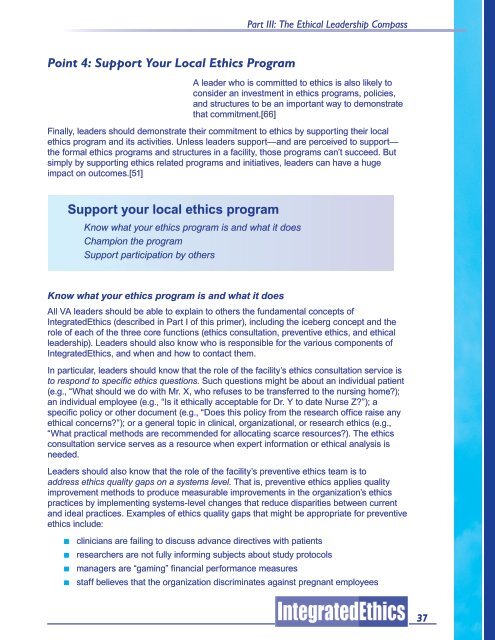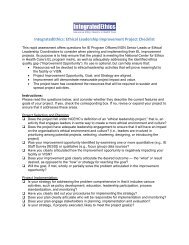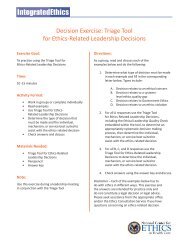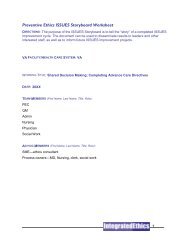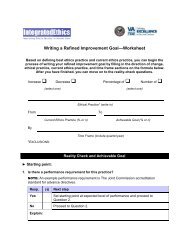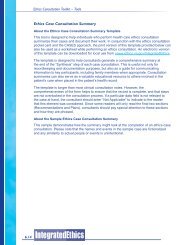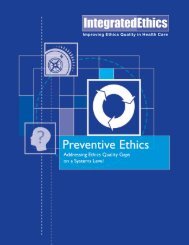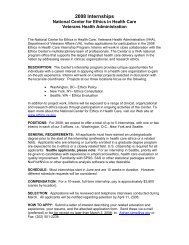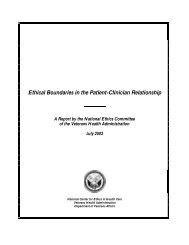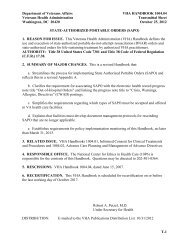Ethical Leadership: Fostering an Ethical Environment & Culture ...
Ethical Leadership: Fostering an Ethical Environment & Culture ...
Ethical Leadership: Fostering an Ethical Environment & Culture ...
You also want an ePaper? Increase the reach of your titles
YUMPU automatically turns print PDFs into web optimized ePapers that Google loves.
Part III: The <strong>Ethical</strong> <strong>Leadership</strong> CompassPoint 4: Support Your Local Ethics ProgramA leader who is committed to ethics is also likely toconsider <strong>an</strong> investment in ethics programs, policies,<strong>an</strong>d structures to be <strong>an</strong> import<strong>an</strong>t way to demonstratethat commitment.[66]Finally, leaders should demonstrate their commitment to ethics by supporting their localethics program <strong>an</strong>d its activities. Unless leaders support—<strong>an</strong>d are perceived to support—the formal ethics programs <strong>an</strong>d structures in a facility, those programs c<strong>an</strong>’t succeed. Butsimply by supporting ethics related programs <strong>an</strong>d initiatives, leaders c<strong>an</strong> have a hugeimpact on outcomes.[51]Support your local ethics programKnow what your ethics program is <strong>an</strong>d what it doesChampion the programSupport participation by othersKnow what your ethics program is <strong>an</strong>d what it doesAll VA leaders should be able to explain to others the fundamental concepts ofIntegratedEthics (described in Part I of this primer), including the iceberg concept <strong>an</strong>d therole of each of the three core functions (ethics consultation, preventive ethics, <strong>an</strong>d ethicalleadership). Leaders should also know who is responsible for the various components ofIntegratedEthics, <strong>an</strong>d when <strong>an</strong>d how to contact them.In particular, leaders should know that the role of the facility’s ethics consultation service isto respond to specific ethics questions. Such questions might be about <strong>an</strong> individual patient(e.g., “What should we do with Mr. X, who refuses to be tr<strong>an</strong>sferred to the nursing home?);<strong>an</strong> individual employee (e.g., “Is it ethically acceptable for Dr. Y to date Nurse Z?”); aspecific policy or other document (e.g., “Does this policy from the research office raise <strong>an</strong>yethical concerns?”); or a general topic in clinical, org<strong>an</strong>izational, or research ethics (e.g.,“What practical methods are recommended for allocating scarce resources?). The ethicsconsultation service serves as a resource when expert information or ethical <strong>an</strong>alysis isneeded.Leaders should also know that the role of the facility’s preventive ethics team is toaddress ethics quality gaps on a systems level. That is, preventive ethics applies qualityimprovement methods to produce measurable improvements in the org<strong>an</strong>ization’s ethicspractices by implementing systems-level ch<strong>an</strong>ges that reduce disparities between current<strong>an</strong>d ideal practices. Examples of ethics quality gaps that might be appropriate for preventiveethics include:• clinici<strong>an</strong>s are failing to discuss adv<strong>an</strong>ce directives with patients• researchers are not fully informing subjects about study protocols• m<strong>an</strong>agers are “gaming” fin<strong>an</strong>cial perform<strong>an</strong>ce measures• staff believes that the org<strong>an</strong>ization discriminates against pregn<strong>an</strong>t employees37


